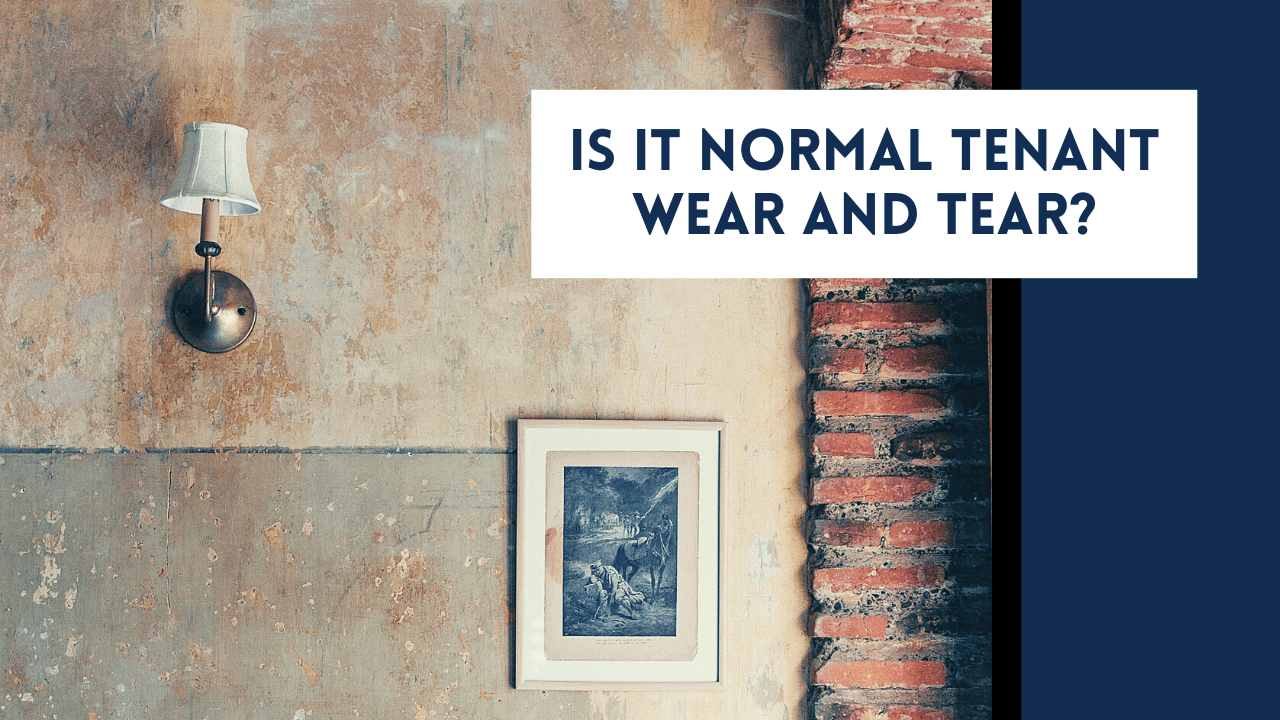Landlords often find it difficult to differentiate between normal wear and tear and tenant-caused damages. If you are wondering why a clear-cut distinction is so important, well, primarily for security-deposit claim issues, and secondarily to ensure that your rental stays in good condition. As a homeowner, it is your responsibility to keep your Los Angeles property in a habitable state and take care of routine maintenance. However, you are not obligated to cover the costs for the tenant-caused property damages.
Tenants also have their set of responsibilities towards keeping the property clean and using all the items carefully. If you come across damages in your unit during an inspection, check if it is a part of normal wear and tear. If not, these are most likely property damages that you are not obligated to pay for out of your pocket.
If you are wondering whether certain damages are a part of natural wear and tear or are inflicted by the renters, here are some useful insights that can help.
What Is Considered as Normal Wear And Tear In Los Angeles?
With time and regular use, a house naturally deteriorates. Wear and tear often make the property look dull or cause small and rectifiable damages. As a result, many items like furniture, mattresses, and carpets tend to lose their fresh look. Also, items like appliances or furniture stop working when they are close to the end of their lifespan.
As these damages are unavoidable, you, as a landlord, do not have the right to deduct the repair costs from the security deposit. Rather, you must pay for the repairs and do everything you can to improve the property condition.
What Are Tenant-Caused Property Damages?
Damages caused due to tenant's negligence or/and abuse, forgetfulness, or delinquency, do not qualify as natural wear and tear. You may deduct the restoration costs for such damages from the security deposit. Hence, if you detect such damages during inspections, we would suggest you immediately document them.
Identifying Whether It's Normal Wear and Tear
As experienced property managers in Los Angeles County, we are capable of identifying the silver lining between normal wear and tear and property damages with respect to a few common items. Here are some mainstream items in the home that undergo maximum wear and tear.
1. Carpets
Carpets typically have a long lifespan of nearly 10-25 years. If you placed new carpets just 2-3 years ago, and they are worn out beyond reconditioning, it cannot be due to regular wear and tear. Some other serious carpet damages that cannot be justified as wear and tear are:
Carpet soaked with fluids like pet urine
Burnt carpets
Big holes or too many small holes in the carpet
On the other hand, if the carpets have small stains, are a little ripped at the edges, look faded, or stink, these are wear and tear damages and won't require you to change the carpets.
2. Walls
Deteriorations like faded walls can really downgrade the look of a home. But since it might not necessarily be tenant-caused damage, landlords find it hard to clearly identify the source of damage. If you are experiencing a similar problem, let's simplify it for you.
Good paint on the wall should stay intact for about 3-6 years. Some wear and tear issues like faded paint, washable stains, or a few chipped corners can give the walls a drab look. But these are regular wear and tear issues, and you can't do much about it.
However, if you see unauthorized paint on the walls, too many nail holes, pet scratches, several chipped patches, or big food stains, it is certainly tenant-caused damage that could have been avoided.
3. Mattresses
If you find that the mattresses in your Los Angeles property are damaged, you would want to know if they are due to wear and tear. Check if the mattresses are dull, dusty, discolored, have washable stains, or have a few small threads coming out of them. These can be counted as regular damages.
On the other hand, if you find that your mattresses are ripped, have big stinky stains, holes, or the cotton or the cloth is peeping out, or half of it has already come out, they are a result of the tenant's negligence or abuse.
4. Curtains
Depending upon factors like the fabric and the weather conditions, curtains can last for 3-10 years. If the texture of the curtains fades out, looks discolored, or gets too dusty, these are signs of regular wear and tear.
However, if the curtains are torn, have dark unremovable stains, or have unprofessional stitch marks, they are property damages and will most likely need to be replaced.
5. Furniture
Furniture is typically made for rough and tough use, and you shouldn't see much damage to it. When inspecting the furniture of your Los Angeles home, if you find that items like the sofa handles, cabinet doors, or furniture legs are broken, it is certainly beyond the regular wear and tear. But, if the handles are loose, some of the screws have fallen off, or the furniture is lightly stained, you can consider them as natural wear and tear.
6. Faucets And Doorknobs
Items like faucets and doorknobs undergo significant rough use. So checking the condition of these can be challenging. However, if you know the basics, it can get very simple for you. For instance, the doorknobs can get loose, drop a few screws, or look discolored due to regular wear and tear. Similarly, the faucets can get tighter or stiff, leaky, or clog due to normal use.
However, if these items are broken, missing, or damaged beyond repair (while they are not too old and in good condition), they result from the tenant's negligence or abuse.
7. Countertops
The countertop is one of the highlights of a kitchen and must be maintained really well. If you find the countertops of your Los Angeles home clumsy, uncleaned, or faded, don't be surprised, as it is common wear and tear. However, if you see that the countertops are ruptured, cracked, chipped, dislocated, or are moving, these are some serious intentional damages.
8. Mirrors
When inspecting the mirrors, draw a line between lack of cleanliness and abuse on the tenant's part. It won't be a pretty sight if there are blemishes on the mirror, but these can be caused due to regular use. Even loose screws or tarnished mirrors are an outcome of daily use. If the mirror is broken from the ends, has permanent stains, is not in one piece, or looks impaired with pieces joined together, it is undoubtedly damage.
Other Common Concerns About Wear And Tear
You might have many other questions related to wear and tear, and some of the following answers can simplify your problems.
What if the toilet seat is broken?
Regular wear and tear cannot lead to a broken toilet seat. It can break as a result of the tenants placing some heavy object on the seat/lid and did not use it carefully.
What if some old appliances break?
Appliances come with a lifespan too. Typically, cooktops last for about 14 years, refrigerators and dryers for nearly 13 years, and the washing machine can last for ten years. If the appliances have lasted nearly up to or over their respective lifespans, they might stop working. When such age-old appliances break, they cannot be considered tenant-caused damage.
How about damages resulting from a house party?
If the tenants are hosting a party, they must inform their guests about the guest policy in the lease and mention the repercussions of any property damages. If you notice damages like broken pieces of furniture, cigarette smoke or ashes under or over the carpet, on the mattresses, or massive stains on the curtains, these cannot qualify as regular wear and tear.
However, if the countertops look unclean or there is too much garbage in the kitchen after the event, you may consider it as wear and tear as long as they clean up the house without any delay.
What if the tenant's pets cause the damages?
Pet damages like scratches on the walls, floors, furniture, or appliances occur due to tenants' negligence. Some other serious pet-caused damages include items like:
- Furniture or artifacts are chewed
- Urine on the curtains, mattresses
- Broken items due to their rough use
- Vomit stains in the house

If you find any pet-caused damages, you have the right to deduct the amount required to make essential repairs from the pet deposit.
We recommend that landlords clearly define the terms related to wear and tear, property damages, and tenant's maintenance duties in the lease. These can make it easier for you to identify damages that are beyond wear and tear and take necessary actions.
If you are struggling to differentiate between regular wear and tear and property damages, we highly recommend you work with professionals like property managers. They know how to protect your properties from damage. They conduct rigorous inspections and document every small change in the unit.
Choose the most trusted company in Los Angeles, Bell Properties. We have been in the Los Angeles property management business for over 16 years. Our property managers know the ABCs of handling rental units and can easily tell if damages are caused due to regular wear and tear or otherwise. We aim to keep your homes in the best possible condition.
For more information, please contact us at Bell Properties.


